Citrus fruits come in a variety of flavors, including zesty and tangy. Citrus fruits have a multilayer flavor that refreshes, delights, and invigorates your taste buds by combining sweet and sour notes. Citrus fruits come in a variety of different colors. Lemons and limes, for example, can be so sour that they make your lips puckery. Others, such as oranges, are delicious and sweet with a tangy flavor.
What are Citrus Fruits?
Hybrids from the three natural citrus fruits are found in all citrus fruits available in the market or grown at home. Pomelo, mandarin orange, and citron are the first citrus fruits to be discovered. All fruits that are classified as citrus fruits have the botanical name Citrus. The Rutaceae family of citrus fruits includes oranges, lemons, limes, and grapefruits. The juicy segments of this tangy fruit family are encased by a zesty rind, which is common.
The botanical name of a citrus fruit will easily distinguish it from other types of fruits. The word “citrus” will appear in all sorts of citrus fruit. Pineapples, bananas, mangoes, grapes, and peaches are all examples of tropical fruits that aren’t citrus. They’re not citrus fruits, they belong to another plant genus. The Citrus genus is not associated with other kinds of fruits such as pomegranate, kiwifruits, and passion fruits.
Citrus Fruits List
Citrus fruits come in a variety of shapes and sizes.
- Sweet oranges (Citrus × sinensis) Navel oranges, Valencia, Hamlin, and cara cara are just a few of the varieties available.
- Bitter oranges (Citrus × aurantium) Raw foods are usually too acidic and harsh to swallow.
- Lemons (Citrus limon) Eureka, Bonnie Brae, Meyer, and primofiori are examples of hybrids.
- Limes Bearss, key limes (Citrus × aurantiifolia), Tahiti lime, and Persian lime are some of the common green citrus fruits available. (Citrus × latifolia).
- Grapefruits (Citrus × paradisi) Ruby Red, Thompson, Oro Blanco, and Star Ruby are some of the more popular citrus fruits.
- Other varieties of citrus fruits Kumquats, yuzu, citron, pomelo, and Buddha’s hand are some of the varieties available.
Types of Citrus Fruits
Let’s take a closer look at some of the most common citrus fruits, which you may eat any time of year. You’ll also find a few lesser-known types of citrus fruit on this list that you might want to experiment with.
Orange

Because of their sweet flavor and numerous benefits, oranges are a popular citrus fruit cultivated all around the globe. The oranges are all hybrids between pomelo and mandarin, two of nature’s original citrus fruits. Small Hamlin oranges, through huge navel oranges with thick orange rind, are among the many varieties of sweet oranges.
- Scientific name: Citrus x sinensis.
- Country of origin: China, but now one of the most cultivated fruits in the world.
Tangerine

Tangerines have a sweet flavor and skin that peels easily, as compared to common oranges. They are smaller, sweeter, and less rounded. The original orange hybrids came from Tangier, Morocco, and the name ‘tangerine’ comes from that. Tangerines are a cross between mandarin oranges and pomelo that has been developed. Tangerines have a distinctively flattened appearance and a stronger sweet flavor when compared to oranges.
- Scientific name: Citrus reticula L. var. or Citrus tangerina.
- Country of origin: Morocco.
Mandarin Orange
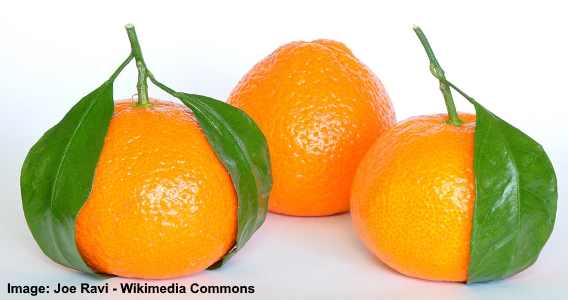
Mandarin oranges are one of the first citrus fruits utilized to create several citrus hybrids, and they’re smaller and sweeter than oranges. Tangerines and mandarins have the same appearance and are often interchangeably referred to as tangerines. Mandarins are smaller, flattened, and have a sweeter flavor when contrasted to sweet oranges. Fresh mandarins may be devoured, and the peel is frequently utilized for its tangy-sweet flavor.
- Scientific name: Citrus reticulata.
- Country of origin: China.
Clementine
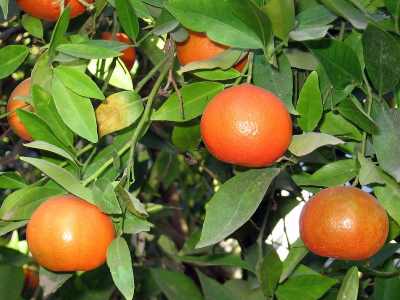
Clementines are one of the most delectable types of fruits since they resemble tiny orange marbles yet are sweeter and have thinner skin that is simple to remove. Because their zesty rind is a deeper orange color, you can easily distinguish clementines from tangerines. They have a honey-sweet flavor with just a small bitterness undertone. A mandarin and a sweet orange are bred together to create the clementine orange.
- Scientific name: Citrus × clementina.
- Country of origin: Algeria.
Satsuma
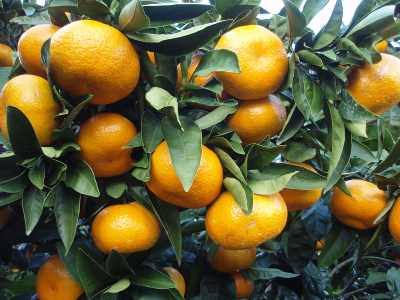
Satsumas are a seedless citrus fruit that tastes wonderfully sweet and are native to China, although they were brought to the West via Japan. Satsuma orange and satsuma mandarin are two names for these tiny, easy-peeling oranges. The intense sweetness of satsumas is one of the reasons why they are so popular. Despite their resemblance to mandarin oranges, they have a thinner skin and more delicate flesh.
- Scientific name: Citrus unshiu.
- Country of origin: China.
Blood Orange

The crimson blushing on a blood orange’s orange skin and bright red flesh distinguish it from a regular sweet orange. These sweet orange fruits have a raspberry-like flavor and are classified as such. Anthocyanins give the red-colored juice portions their hue.
Blood oranges are the only citrus fruit variety that contains this kind of antioxidant, which has numerous advantages. These are not a hybrid but a natural mutation, despite their appearance.
- Scientific name: Citrus x sinensis.
- Country of origin: China.
Lime
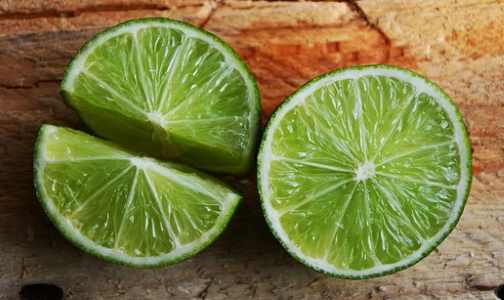
Limes are green-colored citrus fruits with a bitter flavor and are not as sweet as lemons. There are numerous kinds of limes. The most popular types of limes include the Key lime and Persian lime types. Green rind and greenish-yellow flesh are common characteristics of limes. Because their skin becomes yellowish when they are ripe, you may identify them.
- Scientific name: Citrus × aurantiifolia (Key lime), Citrus × latifolia (Persian lime).
- Country of origin: Southeast Asia.
Kaffir Lime
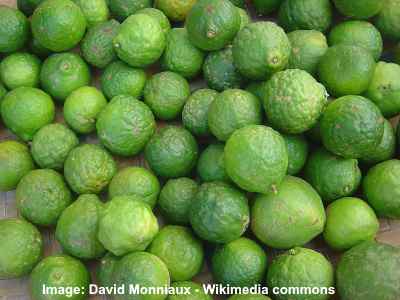
Kaffir limes are a common green citrus fruit with a sharp, bitter flavor that is popular in Asia. The leaves of the Kaffir lime tree are utilized more often than the fruit in Asian cuisine. Kaffir lime leaves add flavor to Thai, Indonesian, and other Asian cuishes, with a lemony-lime taste.
- Scientific name: Citrus hystrix.
- Country of origin: Asia.
Philippine Lime (Calamansi)
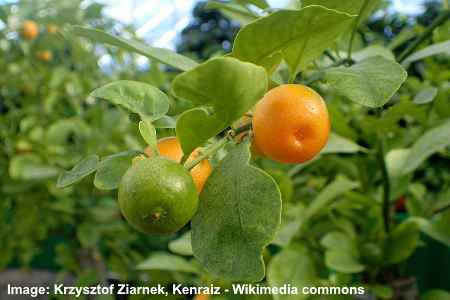
Calamansi Limes (Philippine limes) are a little lime with orange-colored flesh that’s popular in the Philippines. The orange-colored flesh of the Filipino lime resembles a tangerine, although it resembles a regular lime. Calamondin or calamansi are the names for these little orange and green citrus fruits. A cross between a kumquat and a mandarin orange, the Philippine lime is unique.
- Scientific name: Citrus microcarpa,× Citrofortunella microcarpa or × Citrofortunella mitis
- Country of origin: Philippines.
Finger Limes

The finger lime is a colorful fruit with an elongated shape that comes in a range of hues. The shape of this citrus fruit makes it resemble a finger, which is why it is called that. Finger limes have juice vesicles that appear to be little pearls rather than tear-shaped like ordinary limes. Caviar limes are the name given to them because of this. Red, pink, and blue-green varieties of these acidic fruits are commonly served as a gourmet food.
- Scientific name: Citrus australasica.
- Country of origin: Australia.
Rangpur Lime

The Rangpur citrus fruit resembles an orange or mandarin more than a Persian lime, even though it is known as a lime. The peels and flesh of Rangpur limes are orange like a tangerine, and they have a sharp acidic taste similar to limes. Crossing the citron and mandarin oranges results in these orange limes.
- Scientific name: Citrus × limonia.
- Country of origin: Rangpur, Bangladesh.
Lemon

Lemons are yellow citrus fruits with a wide range of flavors, and they are the most common zesty fruit that comes to mind when people think about citrus fruits. These little to medium-sized yellow citrus fruits have a sour flavor and are tiny to medium in size. The juice of one average-sized lemon contains nearly 65% of your daily vitamin C intake, which makes lemons very healthy. Eureka, Lisbon, Meyer, and Primofiori are some of the most popular lemon varieties.
- Scientific name: Citrus limon.
- Country of origin: Northeast India or China.
Citron
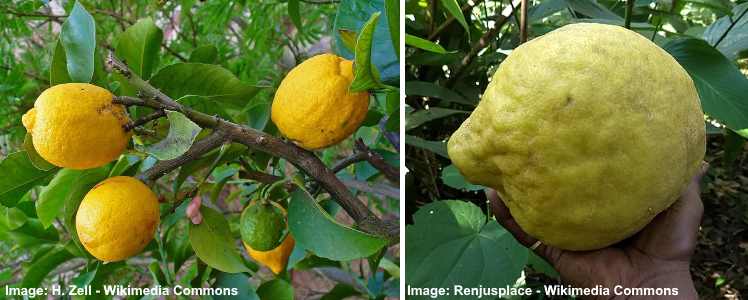
Citron is one of the three principal citrus fruits, and it is derived from all other citrus fruits. This is a gigantic citrus fruit that can reach up to 12 inches (30 cm) in length. It is seldom used in cooking because the flesh is not juicy and has very little flavor. The thick citrus rind, however, is acidic and utilized in Asian and Middle Eastern cuisines as a food. Desserts and cakes may also include the rind, which is candied.
- Scientific name: Citrus medica.
- Country of origin: India.
Grapefruit

Grapefruit is a big subtropical citrus fruit with a wide range of varieties. The spherical fruits develop on the tree in clusters similar to grapes, giving them their smooth skin. The fleshy segments of grapefruits may be pink, yellow, or red, with a yellow-orange rind.
The sweetest grapefruit varieties are usually red, and the bitter grapefruit types are more sour. A cross between pomelo and sweet oranges, grapefruits are a hybrid.
- Scientific name: Citrus × paradisi.
- Country of origin: Jamaica or Barbados.
Tangelo

The tangelo has a rich orange rind and orange pieces, and it is a fragrant aromatic citrus fruit. This tangy citrus fruit has a flavor similar to mandarins and is a cross between a tangerine and pomelo. It’s also a fruit-themed name. Tangelo fruits have a nipple-like shape at the stem end and are roughly the size of a fist.
- Scientific name: Citrus × tangelo.
- Country of origin: USA.
Jamaican Tangelo (Ugly Fruit)

The Jamaican tangelo has greenish-yellow skin that turns orange when fully ripe, and it has a wide bottom and slightly pointed end. Its unattractive look is why it is dubbed the ‘ugly fruit,’ but its flavor more than makes up for it. It has a little bitterness and a pleasant mild juicy citrus taste.
- Scientific name: Citrus reticulata × paradise.
- Country of origin: Jamaica.
Kumquat

Kumquats are similar in size to large olives or grapes, and have edible peel and sweet-sour flesh. Because they are available directly from the tree, these are a kind of citrus fruit that you may eat fresh. Their rind is thin and delectable, and it has a great flavor. Kumquats come in a variety of shapes, including round and oval. The smallest orange variety is Kumquats, which has the honor of being so.
- Scientific name: Citrus japonica.
- Country of origin: South Asia and the Asia-Pacific region.
Pomelo

Pomelo is a big citrus fruit, and it comes in a variety of types. Pomelo is one of the natural citrus fruits species, along with the citron and mandarin orange. The thick rind and sweet white flesh of pomelo fruits, with no trace of bitterness, are the most common varieties.
- Scientific name: Citrus maxima.
- Country of origin: Southeast Asia
Yuzu

Depending on how ripe the yuzu fruit is, it may be yellow or green in color. Yuzu fruits have rough skin and a yellow color rather than an orange color, unlike grapefruits. Yuzu’s succulent citrus segments are seldom consumed. Because they are highly fragrant, the juice and rind of Japanese and Korean cuisines are often used to make beverages or desserts.
- Scientific name: Citrus junos
- Countries of origin: Central China and Tibet
Buddha’s Hand
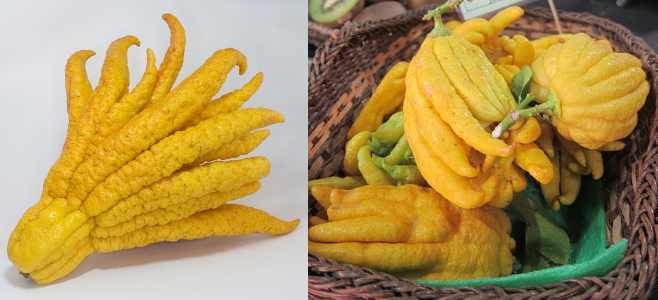
The highly aromatic kind of citron known as Buddha’s hand is one of the most interesting-looking citrus fruits you’ll find. Because the fruit develops in finger-like sections, it’s called fingered citron. These enormous citrusy fruits may also be confused with baseball gloves in certain ways. Only the zesty rind of Buddha’s Hands is used in desserts, savory meals, and to flavor alcoholic beverages. The rest of the hand is not utilized as food.
- Scientific name: Citrus medica var. sarcodactylis
- Country of origin: China or India
Kinnow

While there are some seedless or low-seeded varieties of kinnow, they have a lot of seeds. A cross between Citrus nobilis and Citrus deliciosa, this orange-colored citrus fruit is a hybrid. These orange fruits, which are in the medium size range, have a stronger flavor than ordinary oranges but are much juicier. Moreover, the original species of kinnow has a lot of seeds, making them more difficult to peel.
- Scientific name: Citrus nobilis x Citrus deliciosa
- Countries of origin: India and Pakistan
Bitter Orange

Bitter oranges have a rough, rough, and thick peel. They are a fairly sour citrus fruit. In reality, the raw bitter pulp is unedible. These bitter fruits have a thicker, tougher dimpled skin than sweet oranges and are often referred to as Seville oranges. British marmalade, pickled oranges in Tamil food, and a flavor for gingerbread in Scandinavia are just a few of the uses for the peel.
- Scientific name: Citrus × aurantium.
- Countries of origin: Southeast Asia.
Bergamot Orange

Bergamot oranges are aromatic citrus fruit that look like huge limes and have a yellow or green tint depending on maturity. This bitter orange, on the other hand, does not smell or taste like an orange or a lime. Earl Gray tea’s major flavor comes from essential oils extracted from bergamot orange rinds. Marmalades, to flavor Turkish delights, and aromatic liqueurs are two other ways to use bergamot oranges as food.
- Scientific name: Citrus bergamia.
- Countries of origin: Southeast Asia.
